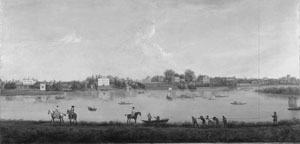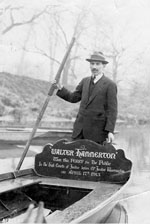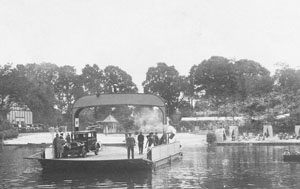River Transport
The river has long been a conduit for the movement of goods and people


From about 1555 watermen between Windsor and Gravesend were licensed and after 1585 the Company of Watermen introduced a one year apprenticeship, extended to seven years in 1603. There was dynastic succession: the Goose, Love, Blower and Hammerton families in Twickenham and Teddington were connected with the river for generations, as were the Benn family in Hampton. Alexander Pope had his own waterman and boat, a punt kept in a nearby boathouse and fitted with a sedan chair so he could travel in comfort. The 18 mile journey to London took about three and a half hours and longer on the return against the current.
Barges are shown with sails in many views but they had to be pulled upstream by men and horses. Heavy barges needed teams of up to sixteen horses to draw them. Glover's map of 1635 shows a barge drawn by five men, on the Middlesex bank below Richmond and another beside Eel Pie Island drawn by a pair of horses. Such men, working in teams were known as 'Scufflehunters' or 'Halers'. There were territorial and charging disputes between gangs of bargemen. Later, towpaths were formed. There were disputes about access and fees with riparian landowners. On the Surrey side at Ham Lord Dysart erected a toll bar, charging horses 3d each.

The Thames has not always been the navigable river we know today. It had many shallows, there were stakes and other obstructions used in connection with fishing, and water extraction to power mills caused problems with water levels and difficulties for barges transporting goods. In 1775 for example there were frequently 20 barges stopped at a time at Teddington due to insufficient depth of water. The lock system of the upper Thames was only developed from 1770. Initially flash locks were used with one gate which released a flash of water which temporarily aided navigation but left water levels very low afterwards. Later pound locks with two gates were developed which increased or reduced the height of the water in the lock. Sluices in the gates only released a lock-full of water. A pound lock was built at Teddington in 1811 with an accompanying weir and one at Molesey, just above Hampton Court Bridge, was built in 1815.

Ferries, of course, provided important transportation across the river. Twickenham Ferry, also known as the Dysart Ferry, was licensed to Henry Horne from 1788. Since 1780 he had been the licensee of the White Cross Inn on Eel Pie Island, predecessor to the hotel built in 1830. This ferry, crossing the river to Ham just below the island is sometimes claimed to date from the reign of King John. The earliest document is a 1692 licence to Richard Blower, although it was included in a list of local ferries forbidden to work between sunset and sunrise, in 1659. Rival ferries have been the subject of litigation more than once. In 1915 Lord Dysart failed in his action against Walter Hammerton who had started a ferry in 1908.
Richmond Ferry existed before 1442 when, following Thomas Tyler, John Yong was granted the licence. Capable of taking carriages, it closed in 1777 when the bridge was opened. A ferry at Hampton Court superceded a ford before 1536 and was itself replaced by the first bridge in 1753. By 1519 Hampton village had its own ferry which operates today. Teddington’s ferry operated until about 1950, although business was lost when the suspension bridge was built in 1899.
With the coming of better roads and railways river traffic declined. Since around the 1860s when local boat building became more to the fore the river was increasingly used for leisure purposes. This trend peaked in late Victorian and Edwardian times and since then has declined and many would say that the river, once so important for the transport of goods and people, is now underused.



